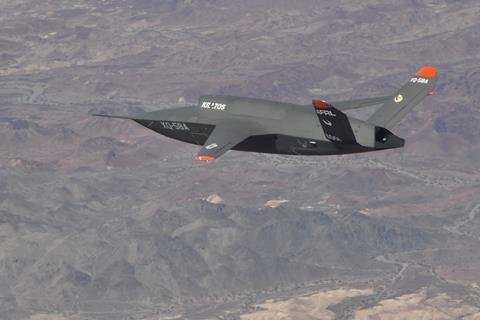The US military plans to counter China’s numerical advantage in the Indo-Pacific region by deploying mass waves of so-called attritable systems – pilotless aircraft that can be replaced for minimal expense.
Speaking in Washington, DC on 28 August, deputy secretary of defence Kathleen Hicks said the Pentagon is unveiling a new procurement effort dubbed the “Replicator initiative” that seeks to adapt existing commercial technologies for military purposes.

“Replicator is meant to help us overcome [China’s] biggest advantage, which is mass,” Hicks says. “More ships, more missiles, more people.”
China’s military has the world’s second-largest fleet of combat aircraft, with 1,570 fighter jets and bombers, according to Cirium data.
Only the USA has more – 2,757 such aircraft. But Washington’s forces are distributed across wide swaths of the globe. Conflicts in regions such as the Western Pacific could require the Pentagon to undertake a complex relocation of forces to there from North America, Europe and the Middle East – potentially through contested airspace.
War games have predicted that US and regional allies could lose 900 aircraft and quickly exhaust supplies of precision-guided munitions in the opening weeks of a hypothetical campaign to oppose a hypothetical Chinese invasion of Taiwan.
Success for the USA in such a campaign is far from assured, with factors such as the supply of long-range missiles and tactical aircraft likely to be a deciding factor, according to the Washington-based Center for Strategic and International Studies.
The Replicator programme aims to tip the Indo-Pacific balance toward Washington’s favour by delivering “multiple thousands” of autonomous, low-cost systems “within the next 18-24 months”, Hicks says.
The focus on aircraft that are low-cost and can operate without pilots is a strategic choice by the Pentagon – one that could reduce casualties and allow Washington to mass far more forces than it could with only crewed fighters and bombers.
“Rarely have America’s war-winning strategies relied solely on matching an adversary ship-for-ship and shot-for-shot,” Hicks notes. “We don’t use our people as cannon fodder like some competitors do.”
While deployment of pilotless aircraft is already a major strategic focus for the US Navy and US Air Force, such technologies were not expected to be ready for frontline service until the 2030s, at the earliest.
The most-advanced autonomous aircraft currently flying – Kratos’ XQ-58A Valkyrie and Boeing’s MQ-28 Ghost Bat – are entirely new classes of multi-role fighter aircraft. Such development efforts come with the lengthy engineering and test periods associated with any new aircraft development programmes.
By contrast, Replicator will focus on leveraging commercial and non-defence technologies to rapidly field new weapon systems. The programme’s guiding principles will be “small, smart, cheap and many”, says Hicks. “[These] are less expensive, put fewer people in the line of fire, and can be changed, updated or improved with substantially shorter lead times.”
That contrasts to existing US strategy, which relies on conventional platforms (such as the Lockheed Martin F-35 strike fighter) that Hicks describes as “large, exquisite, expensive and few”.
Such aircraft programmes tend to be hindered by relatively slow production rates, lengthy pilot training times, casualty concerns and cost – making them less suitable for certain high-risk missions.
Conversely, autonomous combat aircraft are ideal for dangerous operations such as the suppression of enemy air defences.
China has invested heavily in so-called “anti-access area denial” (A2AD) weapons in recent years. That approach relies on high numbers of low-cost guided missiles to overwhelm conventional aircraft.
Swarms of uncrewed autonomous aircraft could be used to destroy A2AD defences, allowing follow-on sorties by conventional fighters and bombers.
The Pentagon plans to announce further details about the Replicator effort in the coming weeks.































